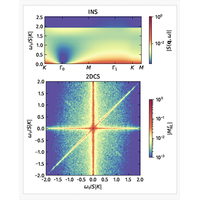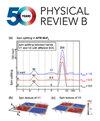利用二维非线性光谱学厘清经典磁体和量子磁体中的自旋激发连续性
IF 3.7
2区 物理与天体物理
Q1 Physics and Astronomy
引用次数: 0
摘要
非弹性中子散射(INS)历来是研究量子磁体的主要方法之一,特别是在识别作为量子自旋液体(QSL)自旋分化标志的激发连续体方面。然而,INS 面临着严重的局限性,因为它无法区分这种 QSL 特征和由具有大单元的高失谐磁序或经典自旋液体产生的类似激发连续体。相比之下,二维相干光谱(2DCS)已成为探究非线性激发动力学的有力工具,可帮助我们深入了解这些宽光谱特征背后的潜在机制。在本文中,我们利用经典分子动力学技术来探索具有主要基塔耶夫相互作用的受挫磁体的 2DCS 响应。比较纯基塔耶夫模型的经典版本和量子版本,我们的结果表明,在尖锐线特征的形式上,两者有明显的相似之处,而在这些特征的位置和选择规则上,两者又有明显的区别。此外,在扩展的 KΓΓ′ 模型中,我们表明基塔耶夫自旋液体的 2DCS 响应与大单元磁序的 2DCS 响应完全不同,尽管两者都在 INS 中产生了宽广的连续。此外,我们还证明了经典 2DCS 对热波动的极端敏感性,并讨论了量子相干性在实验环境中的潜在意义。总之,我们的论文说明了 2DCS 在解决含混自旋激发连续体所蕴含的复杂物理学方面的潜力,从而增强了我们对这些受挫系统动力学的理解。本文章由计算机程序翻译,如有差异,请以英文原文为准。

Disentangling spin excitation continua in classical and quantum magnets using two-dimensional nonlinear spectroscopy
Inelastic neutron scattering (INS) has traditionally been one of the primary methods for investigating quantum magnets, particularly in identifying a continuum of excitations as a hallmark of spin fractionalization in quantum spin liquids (QSLs). However, INS faces severe limitations due to its inability to distinguish between such QSL signatures and similar excitation continua arising from highly frustrated magnetic orders with large unit cells or classical spin liquids. In contrast, two-dimensional coherent spectroscopy (2DCS) has emerged as a powerful tool to probe nonlinear excitation dynamics, offering insights into the underlying mechanisms behind these broad spectral features. In this paper, we utilize classical molecular dynamics techniques to explore the 2DCS responses of frustrated magnets with dominant Kitaev interactions. Comparing the classical and quantum versions of the pure Kitaev model, our results indicate both clear similarities, in the form of sharp line features, and clear distinctions, in the locations of these features and in selection rules. Moreover, in the extended model, we show that the 2DCS response of the Kitaev spin liquid is completely distinct from that of large unit cell magnetic orders, despite both generating a broad continuum in INS. Additionally, we demonstrate the extreme sensitivity of classical 2DCS to thermal fluctuations and discuss the potential significance of quantum coherence in experimental settings. Overall, our paper illustrates the potential of 2DCS in resolving the complex physics underlying ambiguous spin excitation continua, thereby enhancing our understanding of the dynamics in these frustrated systems.
求助全文
通过发布文献求助,成功后即可免费获取论文全文。
去求助
来源期刊

Physical Review B
物理-物理:凝聚态物理
CiteScore
6.70
自引率
32.40%
发文量
0
审稿时长
3.0 months
期刊介绍:
Physical Review B (PRB) is the world’s largest dedicated physics journal, publishing approximately 100 new, high-quality papers each week. The most highly cited journal in condensed matter physics, PRB provides outstanding depth and breadth of coverage, combined with unrivaled context and background for ongoing research by scientists worldwide.
PRB covers the full range of condensed matter, materials physics, and related subfields, including:
-Structure and phase transitions
-Ferroelectrics and multiferroics
-Disordered systems and alloys
-Magnetism
-Superconductivity
-Electronic structure, photonics, and metamaterials
-Semiconductors and mesoscopic systems
-Surfaces, nanoscience, and two-dimensional materials
-Topological states of matter
 求助内容:
求助内容: 应助结果提醒方式:
应助结果提醒方式:


